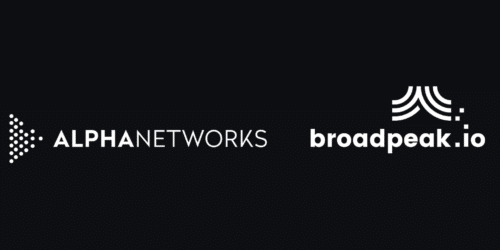After extracting valuable lessons from case studies in the ‘SVOD + AVOD: A Winning Strategy for Content Providers‘ blog post, we will guide you through a step-by-step implementation methodology for a successful ad monetization strategy. This blog post covers everything from avoiding pitfalls to identifying user segments, connecting ad opportunities, and working with the right ad server, ensuring that you maximize revenue through ads effectively.

Learn about ad insertion techniques, content preparation nuances, and final target architecture, as well as tips for enhancing user experience. By following these detailed instructions and best practices, you will be equipped to make informed decisions and achieve a successful deployment, opening up a new and lucrative stream of revenue for your business.
A Road of Challenges
AVOD presents a promising opportunity for SVOD providers, enabling service providers to unlock an ancillary revenue stream while mitigating churn rates. Though AVOD may only be suited for some viewers, it carries the potential to captivate a significant part of the audience, even within affluent markets.
However, transitioning to AVOD is a sophisticated endeavor. From a technical perspective, SVOD providers will need to orchestrate modifications within their existing infrastructures, develop ad sales proficiencies, re-engineer existing content, and accurately gauge the impact of advertising.
One of the most substantial challenges lies in enhancing viewer experience during ad breaks. This doesn’t solely pertain to business rules around ad volume per hour and diversity but involves ensuring seamless ad insertions to deliver a flawless streaming experience. Notably, it’s crucial to acknowledge that content initially commissioned for an ad-free service may require re-editing to determine natural breaks for ad placements. Such complexities underline the challenges we aim to address in the blog post.
Step by Step, follow this implementation methodology to avoid pitfalls
While several components are optional or related to optimization, enabling monetization on a streaming service requires vital ingredients, which are the core building blocks of any ad-supported workflow. Going through the following thought process is a safe approach, as each choice will impact the overall success of such a project.
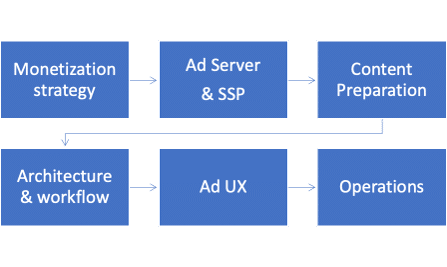
Connecting Ad Opportunities and User Segments – with examples
One of the first business questions to consider when introducing AVOD is positioning the commercial plan for end users. The following diagram shows how some of the leading SVOD and AVOD streaming platforms were pricing their packages in the U.S. market at the end of 2022.
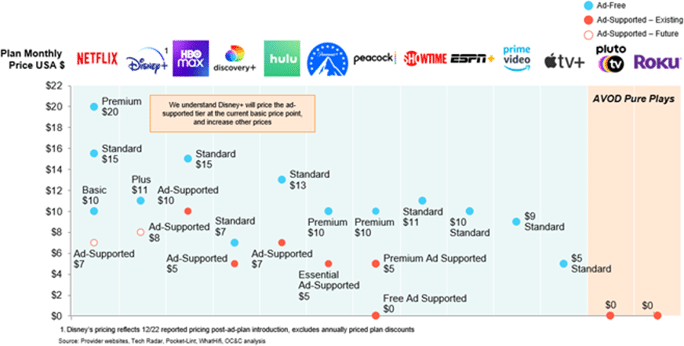
In all cases, the introduction of AVOD packages comes with the definition of business rules leading to specific ad load.
The ad load must then be defined through ad break and ad pod rules to control and protect the impacted QoE.
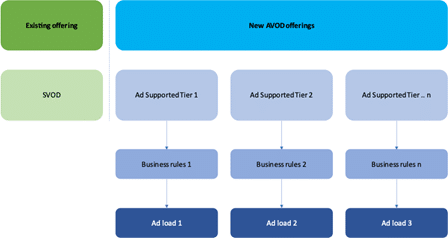
As part of the ad-supported SVOD offer, let’s assume a publisher wants to offer tiered packages:
- Entirely free, fully ad- supported.
- First tier: X$ + Ads.
For this use case, users on the free plan should get four breaks adding up to 10 minutes of ads in total, with no more than two minutes of ads per break.
The lower tier would only get two breaks of a maximum of one minute each for two minutes of ads. A fundamental way to handle this would be to create two segments in your ad server with the following rules:
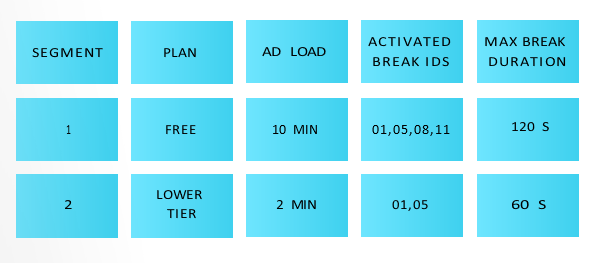
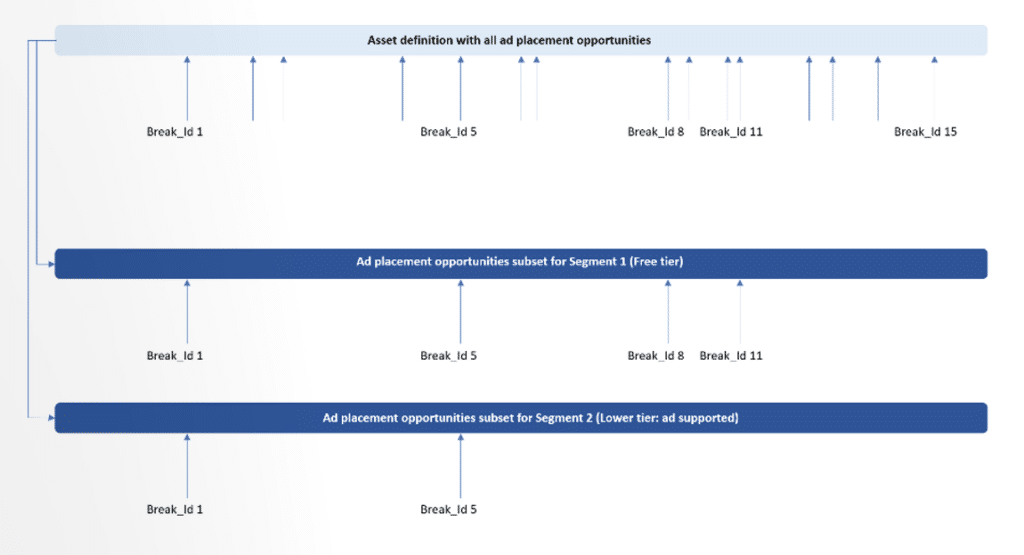
Segment Identification
Defining and identifying the segment the end user belongs to is critical to serving the correct ad load matching the right plan. Using query parameters in client streaming requests is efficient as it is both simple and dynamic. It is vital to increase your value for advertisers and increase the CPMs — for example, Disney segments users by age and Netflix by country and genre. Contact us if you want to know more about this topic.
Sales and Monetization Strategy
On the business side, you must decide on your sales strategy. This can be direct, programmatic, or a mix of both. It would be best if you also decided on the pricing model (i.e., CPM, CPC, CPA, etc.).
Programmatic Deal vs. Direct Deal

Direct Sales:
Direct buying is when an advertiser or brand directly buys advertising on your platform rather than purchasing impressions digitally via an exchange. This method requires a team of sellers to attract brands and an ad operations team to manage the directly sold campaigns. Direct deals are personal and manual, meaning there are no auctions involved. The seller in a direct deal could be the web publisher themselves (if they have the time) or a contracted agency. While programmatic looks at data, direct sales are based on the preferences of the web publisher.
Programmatic Sales:
Programmatic ads are more flexible than direct ads, allowing advertisers to show different ads to viewers based on behavior and preference data, location, and demographic information about each user. This targeted approach allows advertisers to show the right ad to the right viewer at the right time and place. The fundamental difference between direct and programmatic sales is a shift from selling ad impressions in bulk to individual impressions to the highest bidder in real- time (RTB).
Working With a Suitable Ad Server: An Essential Choice
The ad server is critical in delivering advertisements to your users. It determines which ads to show to which users based on predefined parameters.
If you’re integrating with a third-party ad server, you’ll typically use its API to communicate between your platform and the ad server. This will require technical expertise to ensure seamless communication and proper ad delivery.
Selecting an ad server ecosystem is a crucial decision. Some of the critical capabilities you need to consider when choosing such a service include the following features:
- Standards compliance
- Targeting capabilities
- Dynamic ad insertion
- Analytics and reporting
- Scalability
- Reliability and uptime
- Integration capabilities
- Direct sales and
- programmatic support (SSP)
Defining and implementing business rules on how the inventory should be monetized is a must. Typical policies would, for instance, specify the following parameters: ad load, ad distribution, frequency capping, ad skipping, ad sequencing, and priorities within the pods.
Ad Insertion: SSAI or CSAI, Only One Reasonable Answer
Ad insertion points can be pre-roll, mid-roll, or post-roll. Pre-roll ads are shown before the content begins, mid-roll ads are shown during the content (like traditional TV commercials), and post-roll ads are delivered after the content ends
Dynamic Ad Insertion (DAI) technology allows you to swap out ads in real time, enabling personalized and targeted advertising. The video stream is segmented into small chunks, and the ads are stitched into the stream on the server side, which makes ad blocking more difficult.
While CSAI (Client-Side Ad Insertion) was initially widely spread in the industry, SSAI (Server-Side Ad Insertion) has gained significant momentum during the last five years. Today, we can consider that the market has adopted SSAI, and that this trend will accelerate over time.
SSAI naturally brings a complete set of benefits that are now much more impactful and sensitive to publishers. Device fragmentation, QoS control and consistency, ad blocking, and ad tracking scheme choice (client-side or server-side) are some of the most efficient benefits brought by SSAI.
Content Preparation and Segmentation: Intricacies of Content Metadata Ingestion and Conditioning
This is one of the most when adding AVOD to an existing SVOD offering. This includes identifying, defining, and tagging ad placement opportunities. In parallel, it also requires the preparation of VOD assets, which will be monetized through advertising at some point. Altogether, there are several fundamental steps associated with the whole process.

This first requirement is directly related to identifying ad placement opportunities required to support the insertion of ads within programs (mid-roll ad break). There are three options to solve this challenge:
| OPTION | SCHEME | DESCRIPTION |
| 1 | Manual | This approach can be long and tedious as it requires comprehensive viewing of each asset within the content library, with a video editor tool, and subsequent marking. This approach does not scale and can be pretty subjective, too. It is better than the arbitrary option but less desirable than the automated approach |
| 2 | Arbitrary | When no other option is available, it is possible to define a regular ad pod insertion pattern, for instance: at 25%, 50%, and 75% of the asset duration, on specific ad servers. The drawback of this approach is that a) it does not consider asset duration (it becomes irrelevant for short- form content), and b) it leads to a poor QoE experience, as ad breaks can happen in the middle of a sentence. This option cannot be considered for premium content. |
| 3 | Automated (or semi-automated) 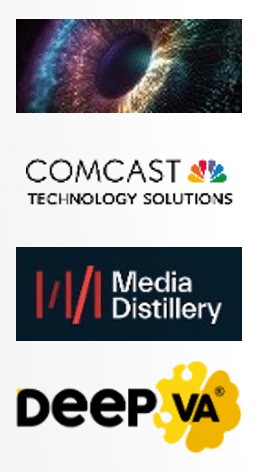 | This is a scalable option. In this case, video analysis tools can automatically scan assets, search for possible ad placement (e.g., a combination of scene change with no audio), and list all opportunities based upon pre-defined rules. In some cases, the workflow can include a manual pass only for the validation of pre-selected cue points, hence leading to a much faster cycle. Tools such as VideoAI™ from Comcast Technology Solutions, Media Distillery, or The Chainless (Deep VA) can leverage AI/ML. Some can even go further into metadata generation (e.g., context-aware metadata) or find the most appropriate/natural cue points to optimize the user experience. |
Whatever the option, the default recommendation is to tag all ad opportunity placements unless you are sure some of them will never be used. Indeed, different subsets of cue points can be used for varying monetization levels (e.g., basic/free package with high ad load) and standard packages (with medium ad load). The objective is to ensure that introducing a new ad-supported commercial package (with a different ad load) does not require additional content preparation work cycles. In addition, those cue points can also be used for FAST streaming applications as potential mid-roll ad break opportunities.
Once the identification and the selection of cue points are made, three things need to happen:
- Metadata generation (such as index, position within the asset, relevance level, etc.) is fundamental to allow the ad server to decide whether a mid-roll ad pod should be inserted.
- Content preparation, aka stream conditioning; this process involves dividing your content into chunks or segments where ads will be inserted. When deciding on segmentation, you must consider the content type and length. From a video processing standpoint, this typically means re-transcoding each asset from a mezzanine format to the target set of profiles by inserting IDR keyframes at the specified cue points.
- Processing of time-based metadata such as subtitle tracks and image tracks (for scrubbing in players), aka preview thumbnails. This is overall a fundamental step and one of the most complex.
This is overall a fundamental step and one of the most complex.

We’re experts in this area.
Reach out for help!
Final Target Architecture
Deploying and operating ad-supported services requires an entire monetization ecosystem. The following diagram shows a high-level overview of what the end-to-end monetization platform may look like. The key components include ad server, SSP for programmatic sale of the inventory, and SSAI.
When CSAT (Client Side Ad Tracking) is used instead of SSAT (Server Side Ad Tracking), it adds an SDK (Site Kit Development) on the OTT ) client to collect advanced monetization and QoE analytics. The content origin is where the VOD assets are stored and originated.
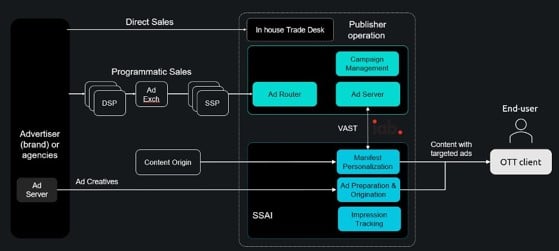
If we dive into the high-level workflow leveraging dynamic ad opportunity placements associated with each asset, the flow of metadata will look as follows:
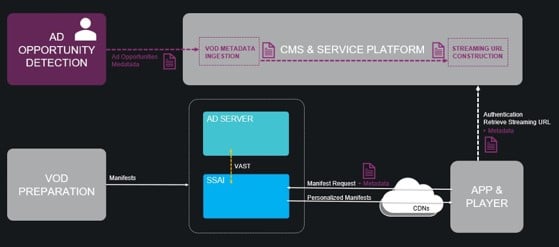
Once the asset catalog has been processed, all metadata can be imported into the CMS (Content Management System) or service platform. This incremental process occurs whenever new content is added to the AVOD catalog.
From a high-level workflow standpoint, upon the end-user client making a request to the CMS or service platform for a specific VOD title, the service platform returns the streaming URL of the selected asset together with the metadata, including the list of potential ad break cue points for this specific piece of media.
For instance, the SSAI can request the ad server through VAST and forward the ad opportunity placements associated with the requested title. Based on the ad campaign rules, end user segment, and commercial package, the ad server can return the appropriate ad pods and ads to the SSAI for this specific AVOD session, using all or only part of the flagged ad placement opportunities.
The whole benefit of such an architecture is to leverage a dynamic workflow inserting the required number and sequence of ads for each AVOD session while maximizing the end-user experience. Changing the business rules in the ad server’s campaign manager will automatically adjust the ad load.
Ad UX: Going Further Regarding User Experience
The ad-watching user experience is a sensitive topic. As viewers are exposed to medium or high levels of ad load, the experience perception of the streaming service is impacted. Several factors have a direct influence on the ad UX:
- Ad preparation (video and audio transcoding of the ad creatives, including format and codec automated selection, audio leveling, etc.). This service is typically part of the SSAI.
- Ad delivery (CDN quality of service)
- Anti-ad skipping rules (policies enforced on the player to ensure minimum monetization (definition of what ad breaks can be skipped or not, in which conditions, etc. )
- End-user preference (new!)
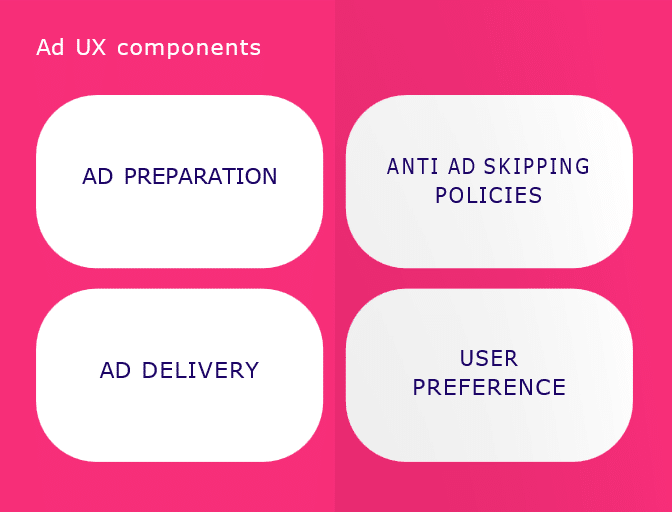
The last topic is intended to let the user decide how to use what ads. This approach has yet to be used on the market, but the technology is available to enable such improvements. Ultimately, letting each user have some control over how the ad breaks are distributed can open the door to an improved QoE. Sometimes, it can remove the frustration created by an imposed ad break pattern. In any case, a better UX leads to a longer watch time, leading to a potentially higher monetization level.
For instance, the following two options could be proposed to end users who subscribed to the same plan and who would get the same ad load:
User setting 1 (default): standard distribution of ad breaks
User setting 2 (custom): user-defined distribution of ad breaks (e.g., fewer but longer ad breaks)
Option two means that the viewer is OK with watching the required number of minutes of ads per hour, but wants to choose the way they are distributed when watching content.
The following screen example illustrates a user-selectable option accessible before watching an asset (for ad-supported plans only).
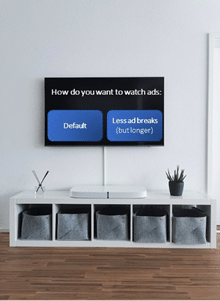
This kind of optimization can be done during the project’s second phase.
Embracing Streaming Evolution: Broadpeak’s Role in SVOD and AVOD Integration – Conclusion
As we conclude this exploratory journey into the marriage of SVOD and AVOD, it is clear that we are standing at a transformative moment in the streaming industry. The convergence of the two models is a substantial shift that reflects an industry evolving to meet viewer demands and revenue stream diversification.
We have unpacked the hybrid model’s benefits, challenges, and strategies for a successful real-life deployment. Adding an AVOD offer on top of an SVOD service is a task to be undertaken seriously. It requires technical expertise in content processing and ad placement as well as a commitment to a pristine viewing experience.
The future of the SVOD+ AVOD model holds immense promise, and Broadpeak is here to help you harness it. Our tools, technology, and expertise are at your disposal, ready to aid in overcoming the technical and strategic challenges of integrating AVOD into your SVOD offering.
With broadpeak.io, Broadpeak’s API-based SaaS platform, we have lengthy expertise in helping our customers to diversify their revenue with AVOD. Our SSAI solution has been designed for customers with complex workflows. With more than 13 years of experience, we are ready to help you today.
The future of the streaming industry is unfolding now. With your and our strengths combined, we can make the most of these exciting developments and shape a more dynamic, diverse, and viewer-centric media landscape. The next chapter in streaming is waiting to be deployed. Let’s deploy it together.





